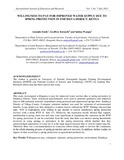Willingness to pay for improved water supply due to spring protection in Emuhaya disrict, Kenya

View/
Date
2013Author
Amondo, Emily
Kironchi, Geoffrey
Wangia, Sabina
Language
enMetadata
Show full item recordAbstract
This study investigated willingness to pay for improved water services due to spring protection in
Emuhaya District. Semi- structured questionnaires were used to generate qualitative and empirical
data on 200 randomly selected respondents using protected and unprotected springs from Emuhaya
District of Vihiga County. Contigent valuation method was used for valuation of environmental
benefits. Logit model was then adopted to evaluate factors influencing WTP. Findings showed that
upto 93% of respondents were willing to pay inorder to receive satisfactory spring protection
services with a mean WTP of Ksh 111. Moreover, the regression results showed that support,
membership to group, farm size and time were significant in explaining the variations in the WTP
for spring protection. It can be concluded from the study that there was interest among households
involved in using springs to participate in the spring protection which implied that they
acknowledged importance of water for it is the main natural resource that is vital for improving life.
Therefore there was a recommendation on conscious efforts being made to involve the community
in the whole planning process of spring protection and cost recovery. In addition, further studies on
impact of time saved due to spring protection on agricultural productivity.
ISSN: 2201-6333 (Print) ISSN: 2201-6740 (Online) www.ijern.com
2
1. INTRODUCTION
Maintainence and protection of water supply systems for communities that access water from
natural sources such as rivers, streams, ponds and springs has received increased concern. Though
some few rural communities in Africa have been able to improve their water supplies, most of them
have not because they consider water from natural sources free. Hanemann (2005) argued that water
has an economic value only when its supply is scarce relative to demand and whenever its available
in unlimited suppy its free in economic sense. Nevertheless water has traditionally been regarded as
a “free” good instead of a scarce good in water economics. Hence people neglect the value of water
because they can obtain it freely, it has no price, not scarce, its a common property and is not traded
in a market.
Kenya surface water coverage is only 2%, a water scarce category of 647m3 per capita against the
global benchmark of 1000m3 (KWAHO, 2009) which is further exacerbated by pollution, over
exploitation and degradation of catchments areas, rapidly growing demand for water for most uses
and mismanagement through unsustainable water and land use policies, laws and institutions (GOK,
2006). This water crisis leads to a growing demand over limited water endowment which in turn
generates competition and causes conflict over water supply hence adversely affecting the poor and
communities without adequate representation in allocation of decision making (GOK, 2006).
Kenya has embedded its water sector reforms into overall poverty reducing strategies in the vision
2030 (Sattler, 2010). Moreover, there is a link between water and poverty which is clearly spelt in
the Poverty Reduction Strategy Paper (PRSP) and MDGs where the specific targets rely on the
improvement in water sector (Sattler, 2010). PRSP recognizes that water is a basic need and
important catalyst both for economic and social development (GOK, 2006). Similarly, achieving
MDG target on safe water and sanitation will enhance achieving other MDG targets on gender
equity, reduced poverty, improved child attendance to school, and reduced waterborne diseases
which are major causes of child mortality and other MDGs. Therefore, the major focus is on the
fight against poverty and seeks to “halve by 2015 the proportion of people without sustainable
access to safe drinking water and sanitation becomes important target (Sattler, 2010).
Investigations have shown that when springs are properly developed, maintained and treated, they
can be can be a reliable source of clean, low-cost, high-quality drinking water (Weigmann et al,
1999). They therefor
Citation
Emily, A., Kironchi, G., & Wangia, S.Willingness to pay for improved water supply due to spring protection in Emuhaya disrict, KenyaPublisher
University of Nairobi
